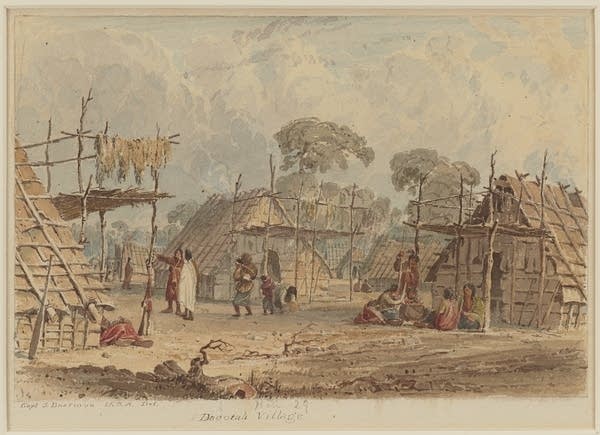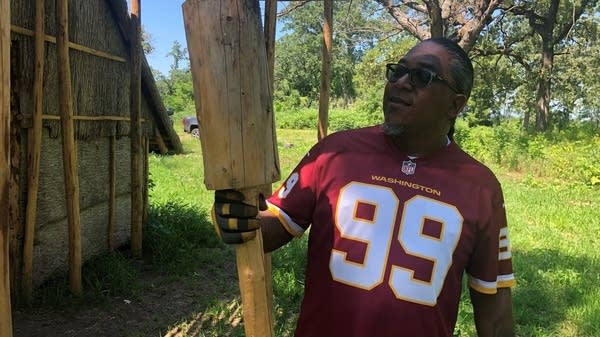Prairie Island celebrates the first bark lodge in 150 years

Go Deeper.
Create an account or log in to save stories.
Like this?
Thanks for liking this story! We have added it to a list of your favorite stories.
In a small clearing known as the winter camp, just yards from the Mississippi River, a structure encompassed by tall grass prairie and oak savanna, offers a glimpse of the past and maybe the future.
In June, Prairie Island Indian Community members built the first permanent traditional Dakota bark lodge in Minnesota in nearly 150 years. The last record of a traditional bark lodge built here dates back to the Lower Sioux Agency in the spring of 1862, right before the U.S.-Dakota War. After that the vast majority of Dakota people were on the move.
At one time, in the area that is now downtown St. Paul there was a large Mdewakanton Dakota community named Kaposia. It comprised some 400 bark lodges according to some accounts. In his writings, explorer Jonathan Carver described the many Dakota bark lodges as cities, instead of villages. Each lodge typically housed between 12-25 people.

While using the same framework Prairie Island’s bark lodge is on a slightly smaller scale.
Turn Up Your Support
MPR News helps you turn down the noise and build shared understanding. Turn up your support for this public resource and keep trusted journalism accessible to all.
"We basically built this lodge from pictures, we did not have an actual blueprint, with numbers and measurements and everything,” Samuel Wells said.
Wells is a Mdewakanton Dakota member from Prairie Island, who participated in the build.
"We just started out from putting one log on the ground, and building from front to back and then around on the sides," he said.
This all began with Barry Hand, the community's language and culture instructor. He proposed building the lodge with grant money as a way to connect members with their culture.
First he reached out to Gun Lake Band of Potawatomi and Michigan members, Frank Sprague and Kevin Finney. They have a 30-year history of building woodlands-style lodges in southeastern Canada and the Great Lakes Region. Hand said they stressed they wouldn’t come unless the Prairie Island community really wanted it and that some of the roughly 1,000 enrolled members took part in the build.
“They said ‘It doesn't have to have tons of people, but we want to know that the community has interest. Otherwise, you know, we're not. We're not just building lawn ornaments here. We're trying to rebuild nations.’"

The community responded. When work began there were usually 30-40 people at the site by 7:30 each morning. That number would often be three times that by later in the day. They used 19th century paintings including some by Seth Eastman as references.
Prairie Island imported tamarack from Wisconsin for the frame. Traditionally, the sacred cottonwood was used but it weakens over time and the community wanted something that would last longer.
The elm bark for the exterior took more traveling. Because Dutch elm disease killed off most of Minnesota’s American Elms in the 1980s, Prairie Island members traveled to Indiana to harvest the elm bark there. It needed to be kept wet the whole way back to Minnesota so it could be formed onto the lodge frame. Once dry, it hardens like a shell.
Hand says the effort was worth it.
"When we started to cover the lodge a healing happened for a lot of the folks there because something was reconnecting, part of that sacred hoop was being mended here at Prairie Island."

The final and most crucial step was the addition of the scaffold platform to the front which is the mark of a Dakota lodge. Historically, it was used as a place to hang implements and clothes and to dry food. And in the summertime, boys would sleep on top of it to make more room in the home. While the lodges were used for ceremonies and a place to gather and stay in the summer months, winter living was done in traditional teepees while the lodges were used for storing items.
During the process and since completion many tribes from Minnesota, the Dakotas and Nebraska have visited the site and some have inquired about building their own lodges.
Prairie Island President Johnny Johnson recognizes the importance this lodge holds for his community.
"It's proven now in today's society of the way of life and for the survival of the Mdewakantons back in those days,” he said. “We look forward to many gatherings at the lodge for our youth and elders and talking about how and what has happened in these lodges in those days. And so we're very excited about the first lodge being built here."

Back at the bark lodge, Wells cleans up some scraps left from the construction.
“To be a part of this, to actually have my hands on these logs and this bark and putting these things in the ground and putting it in place, I'm very, very proud. It makes me very, very proud to be Dakota and to be a part of what was natural back then.”
The Prairie Island Indian Community has already held several functions at the lodge. Now there are plans to start building another one in May of 2023, signifying a much-needed healing over a century in the making.


